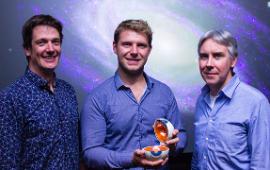Eyes on the sky

In Summary
- Swinburne astrophysicists are working with scientists at the Centre for Eye Research Australia to better understand the mathematics behind diagnosing eye diseases
- They will apply big data analysis used by astronomers studying the Universe to the field of ophthalmology
- The aim is to allow faster and earlier diagnosis of ageing eye diseases
Scientists at the Centre for Eye Research Australia (CERA) are teaming up with Swinburne astrophysicists to better understand the mathematics behind diagnosing eye diseases.
The team, led by ophthalmologist Dr Peter van Wijngaarden from CERA and Associate Professor Christopher Fluke from Swinburne’s Centre for Astrophysics and Supercomputing, will work together to apply the same big data analysis used by astronomers in their study of the Universe, to the field of ophthalmology.
CERA researchers want to use these principles to improve their understanding of the data generated with a new type of spectral imaging camera, which provides unique insights into diseases of the eye and brain including Alzheimer’s disease.
“We hope to learn from the Swinburne team how to ‘crunch the numbers’ more effectively, so we can generate clinically relevant information to allow faster and earlier diagnosis of ageing eye diseases in the future,” says Dr Xavier Hadoux, postdoctoral research fellow at CERA.
“Astronomy is a great training ground for tackling big data challenges,” says Swinburne astronomer Dr Edward Taylor, who is also involved in the project.
“The hyperspectral camera works on a very similar principle to instruments that astronomers use to study how distant galaxies work.
“We are excited by the opportunities to work with CERA on transferring our approaches to a new discipline, and we expect to learn new ways of studying our data in return.”
The collaboration will be formalised thanks to a generous donation from Australian entrepreneur Dr Steven Frisken, CEO of ophthalmic tech company Cylite. He was one of four people jointly awarded the Prime Minister’s Prize for Innovation.
Dr Frisken and his colleague Dr Simon Poole received the prize for their work to transform optical telecommunication networks by developing the optical switching technologies that are needed for efficiently connecting the global internet.
“It is truly inspiring to me that the spectrum of light – whose different colours are central to inter-connecting us all through a web of optical fibres across the globe – also brings information to us about farthest galaxies or reveals hidden terrestrial information through satellite imagery,” Dr Frisken says.
“These same photons and colours can also be used to probe the tiniest structures of the eye. I’m thrilled to be helping to enable this this multi-disciplinary research, which leverages discoveries and world-best expertise from these apparently disparate fields. The outcomes could be revolutionary in providing a window to non-invasive screening and support of therapies for many diseases of our ageing population.”

